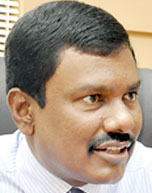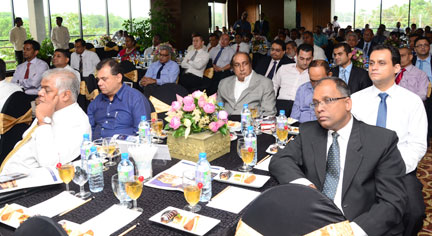|
Developing prime lands in Colombo:
Under-served communities to benefit
By Dhaneshi Yatawara
Colombo is on an expeditious track to become a hub for economic
development. It has already become a safe city, free from fear, a
spacious place to breath in fresh air and decorated with green and shade
– with a view easy on the eye. Colombo which has a high potential for
investment, needs more land for business purposes. According to
calculations Colombo can free up to 400 acres of commercially viable
land.
 |
|
Additional Secretary,
Ministry of Defence and Urban Development, Eng. Rohan
Seneviratne |
According to the statistics available with the Urban Development
Authority, nearly 53% of Colombo’s population, live in under-served
communities such as shanties, shabbily maintained apartments and
line-houses.
Congested
There are shanties or squatters, slums, dilapidated labour quarter
sites, service schemes and low cost flats clustered in different parts
of Colombo metro. Shanties or squatters could be considered as the worst
of its kind. These categories of settlements are extremely congested and
these habitats do not have basic amenities, and frequently inundated
during rainy days resulting in damp soil and unbearable smell.
Within Colombo, these communities live on nearly 900 acres of land.
According to the UDA the number of households to date in these
communities is more than 68,000 with a population of over 300,000. Over
half of the residential population in Colombo live in low-level housing,
occupying only 10 percent of the total area of Colombo. The lands they
live in are mostly in the northern and eastern parts of Colombo such as
Modera, Borella and Dematagoda.
New phase
The plan is to provide housing facilities for families living in
these under-served settlements through the development of prime lands in
Colombo. The Urban Development Authority will implement these programs
with private sector developers.
The policy of the Government under the Mahinda Chinthana - vision for
the future, is to make Colombo and other key cities to be on a par with
environment-friendly modern cities in middle income countries while also
setting up such cities as commercial hubs in South Asia.
The much-needed urban area development is entering a new phase. Urban
area development which was earlier done without proper planning, has now
come into strategic focus under the Urban Development Authority (UDA).
Environment police
 |
|
The Ministry of Defence
and Urban Development and UDA held an Investor Forum recently on
the Metro Colombo Urban Development Project. Here a section of
the gathering. |
“Changes began taking place after President Mahinda Rajapaksa handed
over the UDA to the Ministry of Defence in 2010,” Chairman of the UDA,
Nimal Perera told the Sunday Observer. He said that the organisation
which was once making immense losses was now getting back to its
prestigious position.
“Colombo was a dirty city then. Garbage was lying in piles
everywhere. There were no dustbins to put garbage in. On the
instructions of Secretary Rajapaksa all this came under one system. He
then organised the Environment Police to monitor cities so that people
do not pollute it with garbage,” he said.
In addition to the Municipal Councils and Pradeshiya Sabha cleaning
system he outsourced the cleaning to a few private companies with the
sole aim of properly organising the cleaning system of Colombo city.
Then places to dump the garbage were arranged out of the city limits.
Investors
“Colombo is the most livable city in South Asia. The Ministry of
Defence and Urban Development with the UDA have transformed the city and
now Colombo is ready to receive investments of various business
categories,” said Perera.
According to the Additional Secretary to the Ministry of Defence and
Urban Development Eng. Rohan Seneviratne, 30 acres of land of these
commercially viable areas will be available for investors. It’s the
investor community who can add value to the competitiveness of this
asset, he said.
“Since the Western Province contributes to nearly 50 percent of the
GDP of Sri Lanka it is of utmost importance to make this the most
livable city and gear it up for economic development,” he said.
Assets
“It is vital that we enlighten the business community on the future
development projects of the country and inspire them to become
stakeholders,” he said.
To make the business community aware of these assets, the Ministry of
Defence and Urban Development and UDA held an Investor Forum recently on
the Metro Colombo Urban Development Project.
The Metro Colombo Urban Development Project also known as MCUDP, is
the mechanism that makes a litter-free Colombo with convenient walkways,
better and safe roads and that made pavements obstacle free.
Several other projects are also underway to make Colombo an
eco-friendly and a hub for economic development under the MCUDP.
The UDA has already initiated a massive program to identify unused
but investable lands in Colombo and suburbs and to divest identified
lands among prospective investors.
The UDA has today become a government institution which creates new
avenues to attract potential investment to the country rather than
performing its core objectives.
Urban development was low during the period of terrorism.
However, with the end of terrorism, the government initiated a number
of programs, particularly commercial, city development and
beautification programs. Colombo is now a clean and green city,
attracting foreign investors.
Mihindusenpura
To release these commercially viable lands 15,000 housing units are
under various stages of construction in the Colombo area, according to
the Chairman of the UDA.
The first 500-unit project that was completed and handed over over to
the slum and shanty dwellers in November 2013 – was Mihindusenpura in
Dematagoda. The UDA will continue the project to address the housing
needs of the nearly 68,000 low-income families in these backward
communities.
“Many past Governments attempted to bring a solution to this problem.
Though the UDA had no involvement in those initiatives we can see that
the difficulty in getting lands to rehouse the shanty dwellers and
inadequate funding made those projects collapse,” said Head of the
Project Planning Unit of the Urban Regeneration project under the UDA,
E.A.C. Priyashantha.
Yet this time under the guidance of the Secretary to the Ministry of
Defence and Urban Development, Gotabaya Rajapaksa, the UDA launched the
program, coordinating with other ministries to liberate their lands to
rehouse people and issuing a Rs. 10 billion debenture. When rehousing
had to be done there was a method to get the necessary lands and money
was there to make it a viable project, according to Priyashantha.
The land liberation program is not only confined to Colombo. The UDA
is spearheading projects in key cities of the country like Kandy and
Kurunegala. The intention is to elevate the cities to commercial hubs
along with proper planning, according to Priyashantha.
The Ministry of Defence and Urban Development has recognised the fact
that addressing the housing problem in the city of Colombo should be an
integral part of the overall Urban Development strategy for the western
region of Sri Lanka. The plan is to provide housing facilities to
families living in these under served settlements though liberalisation
and development of prime lands in the City of Colombo. The Urban
Development Authority will implement these programs with the cooperation
of private sector developers.
Cooperation
Yet people living in these under-served communites comprise almost
all the labour force that make the Colombo city function. They are an
important part and parcel of the society. “Many of these people work in
the harbour, Railway Department and Municipal Council forming their
entire labour force. They are playing a pivotal role in the proper
functioning of the Colombo city,” he said.
Numerous solutions were tried ou by successive governments during the
past to find solutions to the City's housing problems but there was no
proper plan of action or firm determination to address the real housing
issue in Colombo with a vision to develop the City of Colombo on a par
with other cities in the South Asian region.
Today the UDA has not only built proper housing for these people but
have taken steps to lay a support line for these shanty dwellers to get
used to their new surroundings. The duty of the project coordination
unit of the Urban Regeneration project is to analyse the true situation
these shanty people live in and coordinate their requirements to the
project management. “All their rehousing locations were in close
proximity to their original homes without taking them away from the area
they were living in for many years,” said Prasad Ranaweera, the Head of
the Project Coordination Unit.
A team of UDA officials from this unit, which also includes graduates
in sociology, have visited every house of these under-served
communities.
“Under the directions of the Secretary to the Ministry of Defence and
Urban Development, Gotabaya Rajapaksa, the UDA first selected the 40,000
shanty dwellers living under the worst conditions among the under-served
communities,” said Ranaweera.
Such communities who were living in Aluthmawatha, Colombage Mawatha,
Cyril C. Perera Mawatha, Wanathamulla in Borella were areas where they
could easily vacate the land.
“The re-housing project is now located in the closest proximity to
their original houses and today back in their original ‘watta’ only few
families remain – mainly due to unsettled legal disputes within their
families and financial problems.
Consent
To those with financial problems we are coordinating with
well-wishers to get support to settle payments for the new houses,” said
Ranaweera. With regard to protests by a few communities initially,
Ranaweera said after the Mihindusenpura rehousing project was completed
in Dematagoda, people of other shanty areas gave their consent.
“People said that they will relocate if they are given houses like
those at Mihindusenpura. And as for the UDA, we were planning similar
projects for these people. We were planning to provide a much better
living standard for these people and they accepted it at the end without
any protest,” he said.
Training the people to use the facilities that were made available
for them in the new apartments was a responsibility of the unit
Ranaweera headed. From dumping garbage systematically to organising
community events, the officials of the unit got involved.
They were there to ensure that the people would happily in their new
homes and surroundings. And this will continue in their future
endeavours too.
The challenge lies in the future. More people settling down in cities
and urban areas is not an isolated event but a global phenomena.
According to UN-HABITAT half of the global population live in cities and
it is predicted that within a decade or two nearly 60% of the world
population, that is around five billion people will become urban
dwellers. Sri Lanka will be no exception.
The next big challenge for the authorities and urban planners is to
face this and ensure the smooth functioning of cities. |

